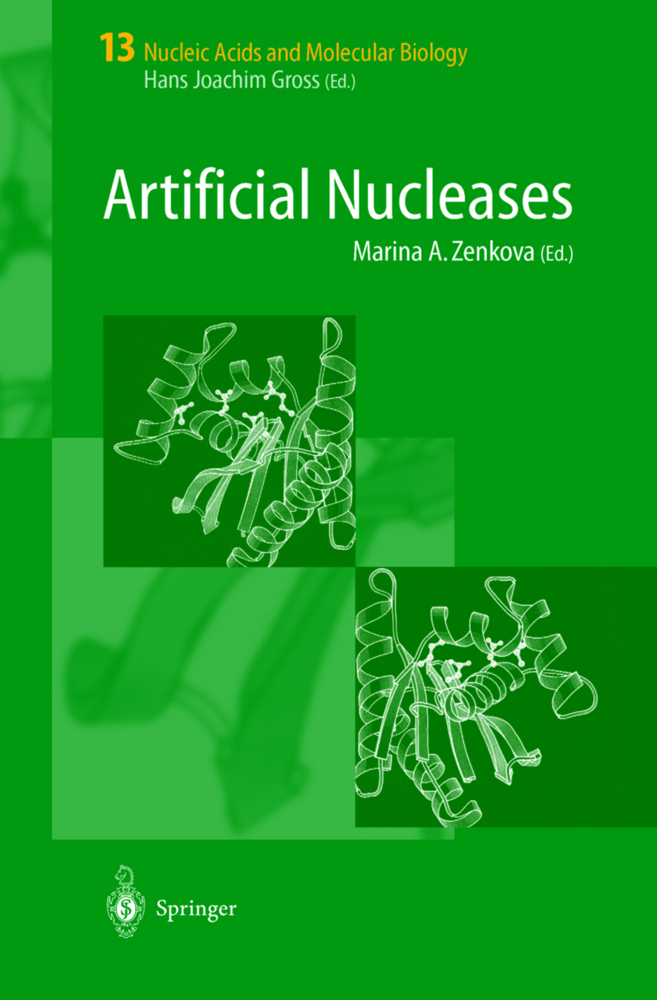Artificial Nucleases
Artificial Nucleases
The development of agents capable of cleaving RNA and DNA has attracted considerable attention from researchers in the last few years, because of the immediate and very important applications they can find in the emerging fields of biotechnology and pharmacology. There are essentially two classes of these agents - nucleases that occur naturally inside cells and synthetically produced artificial nucleases. The first class includes protein enzyme nucle ases and catalytic RNA structured ribozymes that perform cleavage of the phosphodiester bonds in nucleic acids according to a hydrolytic pathway in the course of different biochemical processes in the cell. A different pathway is used by some antibiotics which cleave DNA via redox-based mechanisms resulting in oxidative damage of nucleotide units and breakage of the DNA backbone. The above molecules are indispensable tools for manipulating nucleic acids and processing RNA; DNA-cleaving antibiotics and cytotoxic ribonucleases have demonstrated utility as chemotherapeutic agents. The second class, artificial nucleases, are rationally designed to imitate the active centers of natural enzymes by simple structures possessing minimal sets of the most important characteristics that are essential for catalysis. A dif ferent approach, in vitro selection, was also used to create artificial RNA and DNA enzymes capable of cleaving RNA. Being less efficient and specific as compared to the natural enzymes, the primitive mimics are smaller and robust and can function in a broad range of conditions.
Structural Considerations Concerning Cleavage of RNA
Cleavage of RNA by Imidazole
Principles of Nucleic Acid Cleavage by Metal Ions
Allosterically Controlled Ribozymes as Artificial Ribonucleases
Small Ribonuclease Mimics
Copper-Containing Nuclease Mimics: Synthetic Models and Biochemical Applications
RNA-Cleaving Oligonucleotide-Peptide Conjugates
Sequence Selective Artificial Ribonucleases Employing Metal Ions as Scissors
Site-Specific Artificial Ribonucleases: Conjugates of Oligonucleotides with Catalytic Groups
DNA and RNA Cleavage Mediated by Phenanthroline-Cuprous Oligonucleotides: From Properties to Applications
Sequence-Specific Cleavage of Double-Stranded DNA
Bleomycin-Oligonucleotide Conjugates as Site-Specific Nucleases.
DNA Hydrolysis: Mechanism and Reactivity
Active Site of Ribonuclease AStructural Considerations Concerning Cleavage of RNA
Cleavage of RNA by Imidazole
Principles of Nucleic Acid Cleavage by Metal Ions
Allosterically Controlled Ribozymes as Artificial Ribonucleases
Small Ribonuclease Mimics
Copper-Containing Nuclease Mimics: Synthetic Models and Biochemical Applications
RNA-Cleaving Oligonucleotide-Peptide Conjugates
Sequence Selective Artificial Ribonucleases Employing Metal Ions as Scissors
Site-Specific Artificial Ribonucleases: Conjugates of Oligonucleotides with Catalytic Groups
DNA and RNA Cleavage Mediated by Phenanthroline-Cuprous Oligonucleotides: From Properties to Applications
Sequence-Specific Cleavage of Double-Stranded DNA
Bleomycin-Oligonucleotide Conjugates as Site-Specific Nucleases.
Zenkova, Marina A.
| ISBN | 978-3-642-62139-0 |
|---|---|
| Artikelnummer | 9783642621390 |
| Medientyp | Buch |
| Auflage | Softcover reprint of the original 1st ed. 2004 |
| Copyrightjahr | 2012 |
| Verlag | Springer, Berlin |
| Umfang | XVI, 292 Seiten |
| Abbildungen | XVI, 292 p. |
| Sprache | Englisch |











